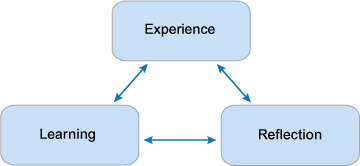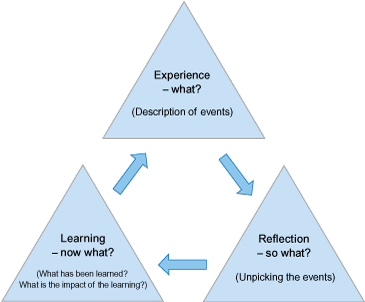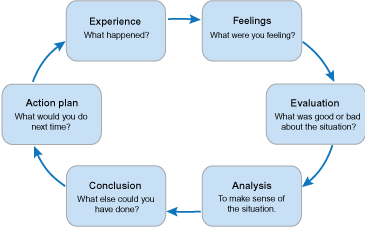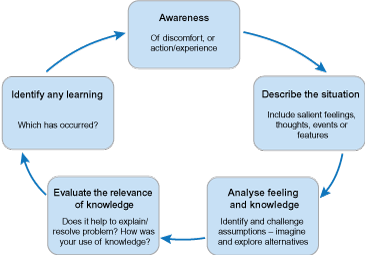4 Models of reflection – core concepts for reflective thinking
The theories behind reflective thinking and reflective practice are complex. Most are beyond the scope of this course, and there are many different models. However, an awareness of the similarities and differences between some of these should help you to become familiar with the core concepts, allow you to explore deeper level reflective questions, and provide a way to better structure your learning.
Boud’s triangular representation (Figure 2) can be viewed as perhaps the simplest model. This cyclic model represents the core notion that reflection leads to further learning. Although it captures the essentials (that experience and reflection lead to learning), the model does not guide us as to what reflection might consist of, or how the learning might translate back into experience. Aligning key reflective questions to this model would help (Figure 3).
Gibbs’ reflective cycle (Figure 4) breaks this down into further stages. Gibbs’ model acknowledges that your personal feelings influence the situation and how you have begun to reflect on it. It builds on Boud’s model by breaking down reflection into evaluation of the events and analysis and there is a clear link between the learning that has happened from the experience and future practice. However, despite the further break down, it can be argued that this model could still result in fairly superficial reflection as it doesn’t refer to critical thinking or analysis. It doesn’t take into consideration assumptions that you may hold about the experience, the need to look objectively at different perspectives, and there doesn’t seem to be an explicit suggestion that the learning will result in a change of assumptions, perspectives or practice. You could legitimately respond to the question ‘what would you do or decide next time?’ by answering that you would do the same, but does that constitute deep level reflection?
Atkins and Murphy (1993) address many of these criticisms with their own cyclical model (Figure 5). Their model can be seen to support a deeper level of reflection, which is not to say that the other models are not useful, but that it is important to remain alert to the need to avoid superficial responses, by explicitly identifying challenges and assumptions, imagining and exploring alternatives, and evaluating the relevance and impact, as well as identifying learning that has occurred as a result of the process.
You will explore how these models can be applied to professional practice in Session 7.




